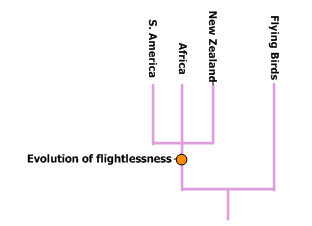I learned about climate change in geology classes but that was about changes over geological time, about the Pleistocene ice ages and the Eocene -Paleocene Thermal maxima and the Mesozoic warm period and so on. All these had natural causes but I am persuaded by the collective scientific evidence that humans are causing the earth to warm up and will contribute increasingly to global warming over the next few decades. But if someone asks me a very specific question, let's say "Can you tell me if there have been errors in the measurement of CO2 recovered from air bubbles trapped in ice", I won't be able to answer that.
A few days ago a friend emailed me
just such an article which accuses scientists of mishandling, misrepresenting and even deceit in measurements and the presentation of climate data. The article is written by a Polish radiologist and well know climate change skeptic Zbigniew Jaworowski. I read through the article realized that a layperson who is not aware of the data favoring human induced climate change might get persuaded that human induced global warming is a fraud. How should I go about making a convincing case that the article misrepresents climate science?
Can I leave aside the specific questions about ice-core CO2 levels, maybe give references that point to original work and then still make broad arguments that show that Jaworowski himself has made very unreasonable assumptions and omitted important facts and that the scientific data is trustworthy. I am going to try doing that. This is a bit like the evolution-creationism debate. I can't answer very specific biological questions like maybe how a particular protein evolved but over the years I have gathered broad arguments in favor of evolution. I have persuaded some of my friends using these broad level explanations of evolution and I am hoping I can use the same kind of arguments to explain climate change.
Right. So here is what I came up with. Feel free to add you own insights and suggestions on how to improve such arguments.
1) Combating the conspiracy theory charge: At the outset Jaworowski plays on people's suspicion of big organizations and huge bureaucracies to imply that the
IPCC report on climate change is a political document. He invokes a world wide conspiracy involving the U.N, large global warming research lobbies (which he does not identify) and the U.S government. Yes, the U.S government wanting to politicize climate science to show
bias in favor of human induced global warming! This has to be one of the greatest perverse jokes of all. This is a government who for the last 8 years has
muzzled its own scientists from presenting the true picture about global warming,
has edited scientific reports from its research organizations to convey the impression that the science is still uncertain, and had to be dragged kicking and screaming to admit finally that anthropogenic warming is true. Has Jaworowski been sleeping in a cave?
But is it possible that the report has been manipulated? I have found that many people have the perception that it is the IPCC which was responsible for the science as well. This is simply not true. Research about climate change has been going on for decades in hundreds of labs, universities and research organizations. Scientists have been working on their pet projects, often on very specific topics, sometimes not even asking directly whether humans are causing warming or not. Their research for example may involve improving methods of estimating past atmosphere composition using tree ring data as proxy. As a result we have measurements of past atmosphere CO2 which some other researcher could use to ask a different question. Our understanding of climate change has proceeded by just such hundreds of individual efforts of data collection, measurements and sharing.
The IPCC has never commissioned any research. It simply appointed a committee to collate evidence into a report.2) Meeting charges of deceit and omission head on: Throughout the report Jaworowski accuses scientists of manipulating data, being selective in their presentations and sometimes outright deceit. But I found Jaworowski does pretty much the same. Here is just one example. He says that “It is true that CO2 is the most important anthropogenic [trace] greenhouse gas, but a much more important greenhouse factor is the water naturally present in the atmosphere, which contributes some 95% to the total greenhouse effect.” Now
water vapor may be contributing a lot to the total greenhouse effect but
this does not explain why the current warming is taking place. The atmosphere is not a homogeneous mixture of gases. It has a layered structure and water vapor is more common in the lower atmosphere. With altitude the atmosphere become drier and colder.
The concentration of CO2 is increasing in these high cold drier layers. These layers are absorbing more heat and warming up. The earth is taking in more energy than it is giving out since these cold layers don't radiate energy much. Eventually though some of that heat radiates back to the lower levels of the earth causing warming.
In an effort to convince that the human contribution to warming is at best negligible he fires the following statistics; 97% of emissions of CO2 in the atmosphere come from natural source, humans account for just 3% of emissions. This 3% of emissions are responsible for just 0.12% of the total greenhouse effect. Again reading the figure 3% and 0.12% is enough to persuade many people that human contributions are at best minimal. But that is not how the figure should be read.
What is important is the carbon budget and exchange of carbon between the three big reservoirs, the ocean, the terrestrial biosphere and the atmosphere. The ocean emits about 330 billion tons of CO2 and reabsorbs a little more than that per year. The terrestrial biosphere emits through organic material decay and plant respiration about 440 billion tons of CO2 but absorbs an equal amount through photosynthesis per year. We know that the oceans are gaining CO2 every year and cannot be a net source of CO2. Ditto for the terrestrial biosphere. Humans emit about 27 billion tons per year out of which about 40% are reabsorbed in the oceanic sink. Which means that the only excess CO2 left in the atmosphere is from human emissions. We know this because we can
fingerprint human emissions in a variety of ways.
This means the correct question to ask is how much of the increase in atmospheric CO2 observed over the last few decades is due to human activity and the answer is not 3% but 100%.Jaworowski’s claim that humans are responsible for just 0.12% of the greenhouse effect is also misleading. The earth is at a comfortable livable temperature today due to the building up of the greenhouse effect by natural emissions of greenhouse gases over the past 4 billion years. Humans had nothing to do with this historic building of the greenhouse effect. So naturally our contribution today to the total greenhouse effect is going to be very small.
What is worrying is that our CO2 emissions henceforth over the next few decades will be making the majority contribution to the greenhouse effect. I won't say 100% because future variations in solar radiation may contribute, but our influence on the greenhouse effect is increasing.
95%, 3%, 0.12% all these numbers can easily confuse but they really mean something different than what Jaworowski is letting on. How is that Jaworowski omits these real implications? And what does that say about his credibility?
3) The past is not always a key to the present: A commonly heard argument and one that Jaworowski also uses is that past climatic changes for example the ice ages were triggered not by changing CO2 levels but by changes in solar radiation and so CO2 is not really an important causative factor in climate change. It is true that the Pleistocene ice ages were likely triggered by natural oscillations of solar radiation operating on a
Milankovitch frequency of a 100,000 years or so. But
that does not mean that CO2 had no role to play in amplifying and maintaining interglacial warm temperatures. This misunderstanding arises primarily because in ice core data, CO2 increase lags the temperature signal by 800-1000 years. Skeptics play on this and claim that therefore historically CO2 has not been an important forcing mechanism for climate change.
Let’s assume that this is true and CO2 had no role to play in the Pleistocene ice age and interglacial warm periods. Does that somehow change the physics of thermal infrared absorption and radiation?
If the ice ages were triggered by changes in solar radiation and did not involve the warming effects of CO2 will certain laws of physics become invalid through disuse? Maybe genes can become nonfunctional through disuse but the laws of physics don’t change. The fact is that increases in CO2 in the atmosphere today will inevitable lead to a more potent greenhouse effect.
That is just basic physics and it is not influenced by which forcing mechanism controlled past warming. Climate change can take place through a variety of mechanisms. You have to evaluate episodes on a case by case basis.
4) Can we trust scientists? Why do I believe one group of scientists (a large group) and not a loner like Jaworowski? My belief has nothing to do with whether I believe personally in the IPCC or whether I am chummy with some of the scientists or whether I find them to be virtuous honest citizens.
What I believe in is the process of science. Scientific ideas are criticized and rethought, data collected and recollected, experiments replicated, instruments re-calibrated when errors are pointed out.
The ideas and data we have today about climate change have withstood the test of peer review and elimination. That is why I believe when the vast majority of scientists tell me that humans have and will continue to contribute significantly to global warming.
But Jaworowski and his ilk don’t participate in this free marketplace of ideas. They prefer ambush marketing. Resort to pot-shots at scientists, circulate documents by chain mail over the internet and confuse people with X Files conspiracy theory yarns. Take a look at Jaworowski’s publication record. All in pretty obscure journals and as the caption says “Two of his papers on climate appear on the website of 21st Century Science & Technology magazine!! And I am supposed to believe him over 2 decades of peer reviewed science?
This is all I have for the moment. There are a few other points I have left out regarding past sea-level changes. Maybe I will tackle those in a later post. If you can point to more references and better explanations do leave behind a comment. As I said these are broad explanations for some misleading statements I noticed in Jaworowski's paper and I am sure climate experts can point out many other problems with his paper. But for now I have a list of references below for some of the specific points regarding climate change.
References:
The gripe that the IPCC report ignores water vapourThe gripe about the lag between temperature and CO2 in ice cores
The gripe about the Mann hockey stick curve Blog on debunking Jaworowski's criticism of ice core data
Some more articles about ice core data
More on Human Fingerprints of Global Warming






